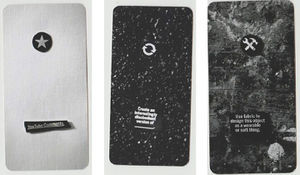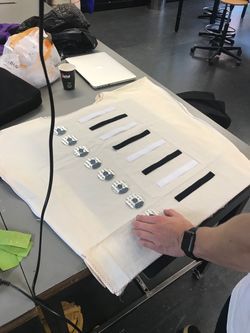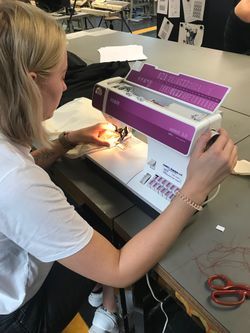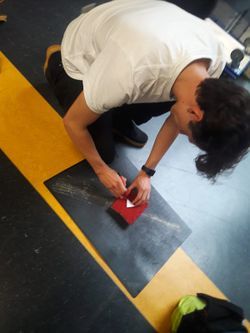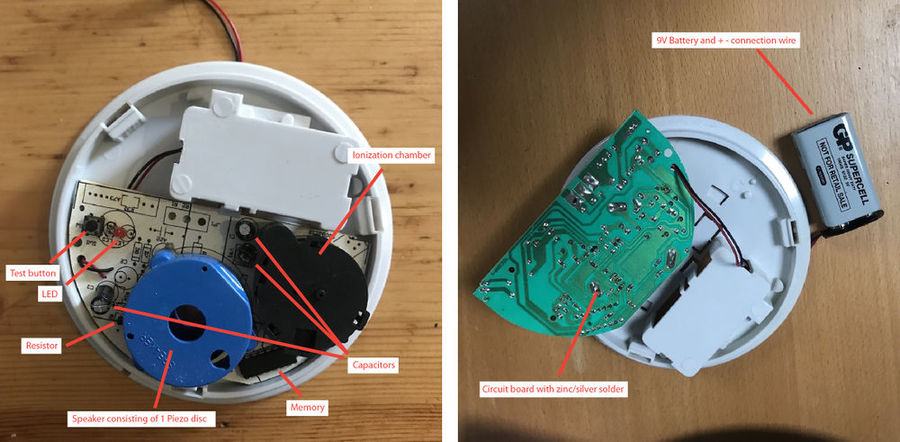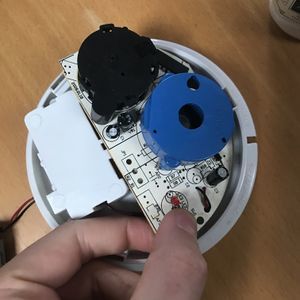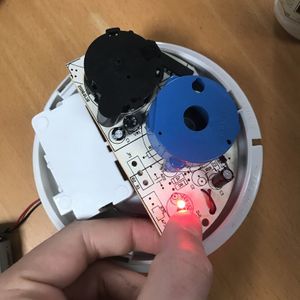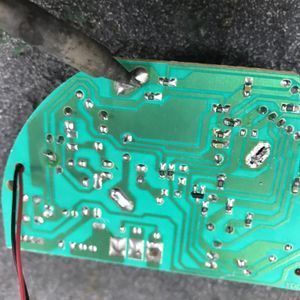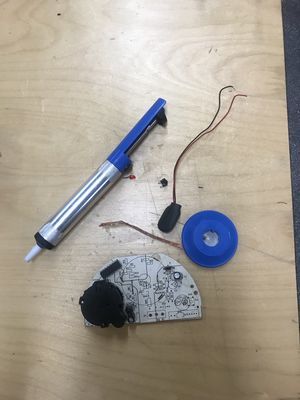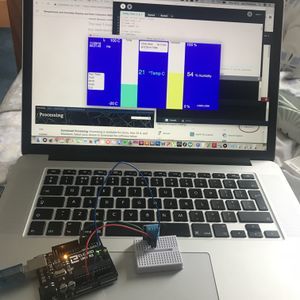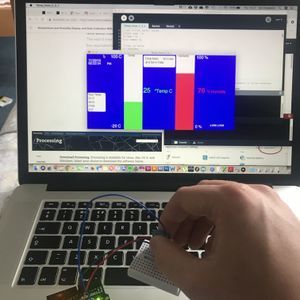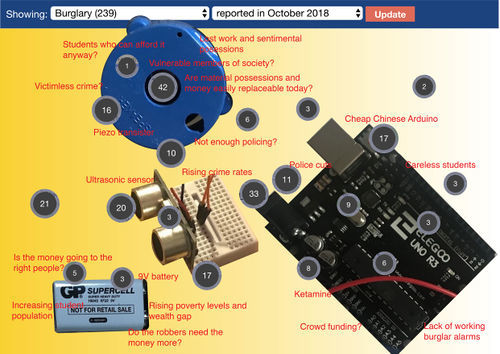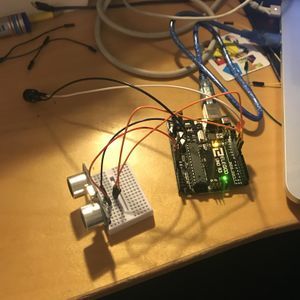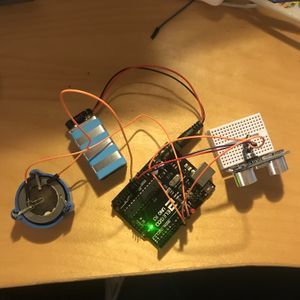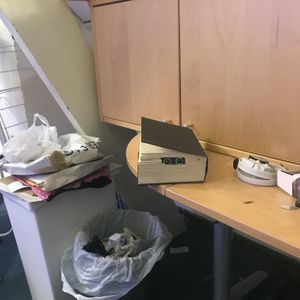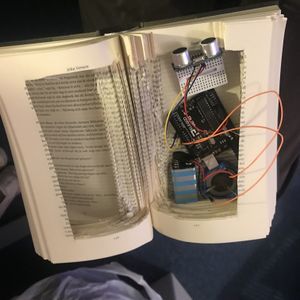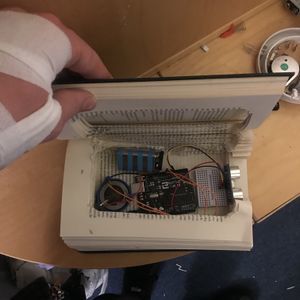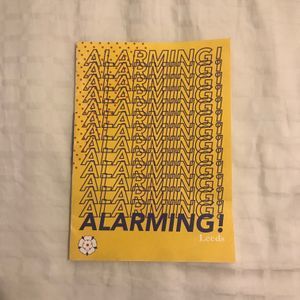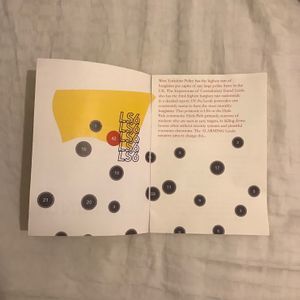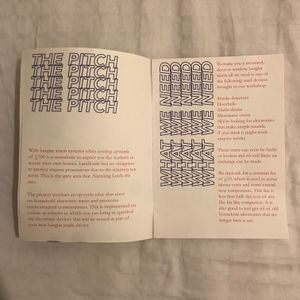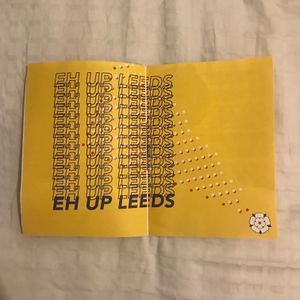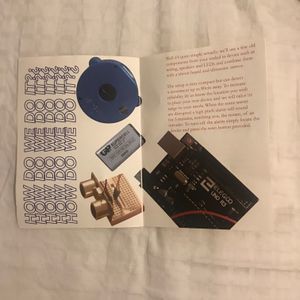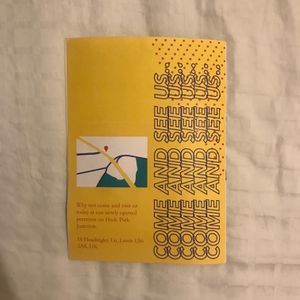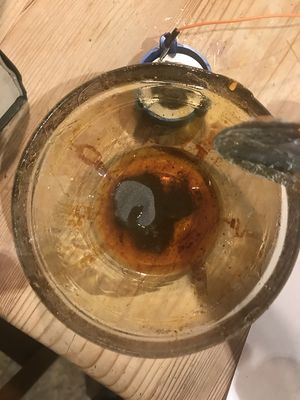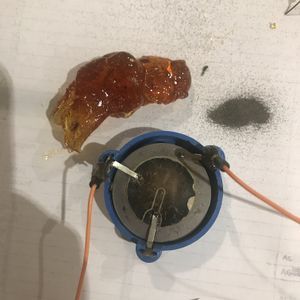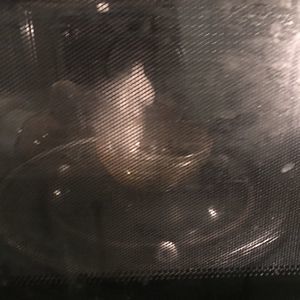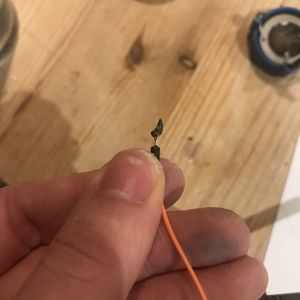Difference between revisions of "User:Solchadwick"
Solchadwick (talk | contribs) |
Solchadwick (talk | contribs) |
||
| (One intermediate revision by the same user not shown) | |||
| Line 274: | Line 274: | ||
https://www.arduino.cc/reference/en/language/functions/advanced-io/tone/ | https://www.arduino.cc/reference/en/language/functions/advanced-io/tone/ | ||
| − | === | + | ===hiding place=== |
With the circuit complete it was time to start considering the vessel within which the alarm would sit. It was essential for it to be concealed well and inconspicuous with a number of mediums being considered including foam, stuffed toys or a draw within a cabinet. However, in the end, the most effective housing was a hollowed out book. This is very much so a continuation of bricolage as everyone probably has an old thick hardback lying around somewhere and a craft knife to cut it. The cutting did not go entirely to plan with a dramatic injury being sustained to my wrist, prompting the recommendation that students gain safety advice from the workshops provided within the initiative. Another minor problem was the slight muffling of the alarm sound via its new housing but this was party solved by a few carefully placed holes in the pages around the central chamber. | With the circuit complete it was time to start considering the vessel within which the alarm would sit. It was essential for it to be concealed well and inconspicuous with a number of mediums being considered including foam, stuffed toys or a draw within a cabinet. However, in the end, the most effective housing was a hollowed out book. This is very much so a continuation of bricolage as everyone probably has an old thick hardback lying around somewhere and a craft knife to cut it. The cutting did not go entirely to plan with a dramatic injury being sustained to my wrist, prompting the recommendation that students gain safety advice from the workshops provided within the initiative. Another minor problem was the slight muffling of the alarm sound via its new housing but this was party solved by a few carefully placed holes in the pages around the central chamber. | ||
| − | [[File: | + | [[File:bookcut1.jpg|300px|left]] [[File:bookcut2.jpg|300px|middle]] [[File:bookcut3.jpg|300px|middle]] [[File:bookcut4.jpg|300px|right]] |
===Branding and Concept=== | ===Branding and Concept=== | ||
Latest revision as of 13:34, 7 January 2019
Contact
Sol Chadwick
0975661@hr.nl
Graphic Design
Project 1
with Vilius Vaura, Sol Chadwick, Sterre van der Helm, Doortje Hogesteeger
After deciding to draw the cards randomly, we ended up with an assignment: "Make YouTube comments disobedient using fabric to design this object as a wearable or soft thing".
We started the process of research on youtube comments, the way they function and what is the main purpose of them. To make them disobedient we wanted to remove the purpose of free will to comment and give feedback on the video content.
While making the wearable of disobedient youtube comments, we came up with an idea of a poncho, that represents the platform of YouTube with "comment" section on the back. The "video content"(person wearing the poncho) is zipped inside and not allowed to interact.
We made representations of the comments out of pieces of fabric and asked people to stick them on the back of our poncho using Velcro. But it didn't stick. So we took away the ability to comment, making the Youtube comments disobedient.
We worked mostly at the Fabric station, learning how to cut and sew the wearable while using hot-glue to attach the details.

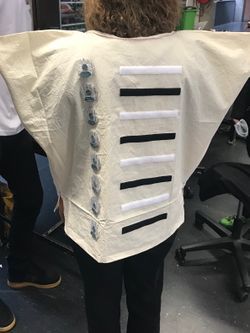
"Comments" in the front pockets and comment section on the back
The final product we ended up with is a poncho, that represents the platform of Youtube. The sleeves have zippers on them, zipping the person (content) inside, not allowing to affect the commenters. On the back, we attached the soft side of the Velcro, where the stips representing comments should be placed. We put the "comments" in the front pockets and during the presentation, we asked someone to come and leave a comment on the back using the fabric strips. When a volunteer came and tried to do so, he found out, that it did not stick and fell off, because both, the comment section ant the comment strips had only soft side of the Velcro and could not stick. This is how the ability to comment was taken away and YouTube comments were made disobedient while removing their main purpose.
To make the YouTube comments disobedient you have to remove their main purpose - the expression of free will, positive or negative, so the ability to comment itself.
The media itself is neutral. Comments make it positive or negative.
Project 2
CalmCat
by Monika Sumauskaite, Vilius Vaura, Sol Chadwick

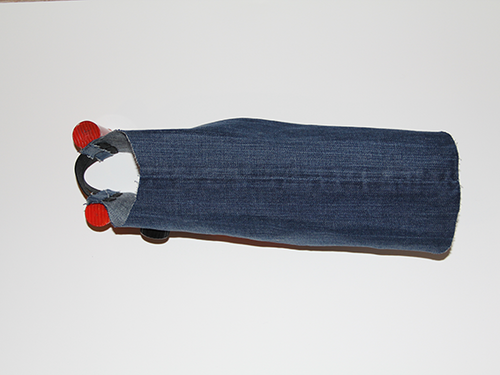
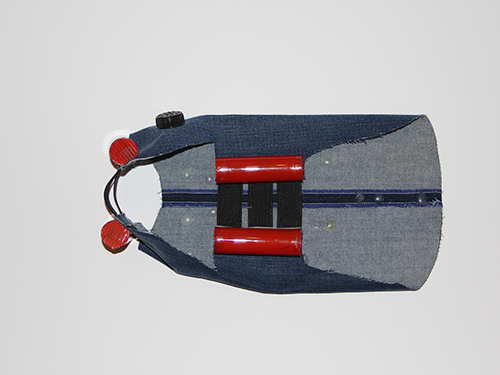
A jacket created to calm down a stressed-out cat. When the cat, wearing this jacket, meows anxiously or an increase of a heartbeat is detected, straps tightness and applies gentle pressure on the belly of the cat, stimulating specific acupressure points, that are proven to have calming effects.
Acupressure points
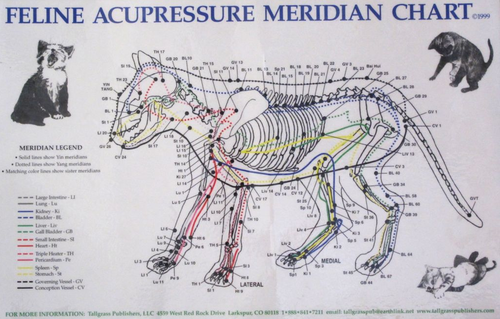
It is known that acupressure techniques can help to relax and overcome stress in humans and animals, like cats. There are multiple bumps on the inside of the jacket to stimulate those points when the cat is stressed. [1][2]
Sound/Heartbeat activation
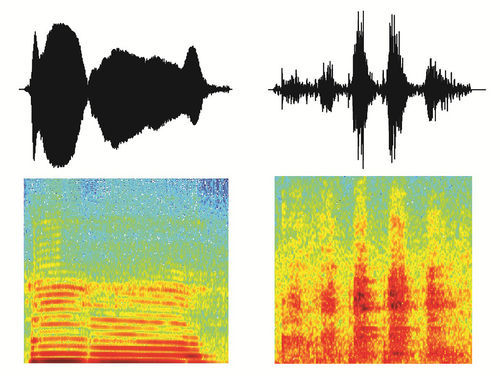

The tightening of the jacket could be activated in a few different ways. The technology could use sound/voice recognition, that would be able to distinguish a stressful meow.
Or a heartbeat sensor could be used. Normal cats pulse varies from 140 to 220 beats per minute. An integrated heartbeat sensor would detect its rise and activate the straps.
Self lacing/tightening technology
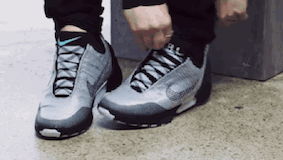
The Calm Cat jacked would include a self-tightening, “cat activated” straps. The technology could work on similar principles as Nikes or Back to the Futures self-lacing shoes.
Project 3
From Devices to systems
The project started orientated around the wireless home phone with a plan to use the receivers and broadcasting apparatus within handsets on a more local scale as a means for electronics within a household to communicate. However after a bit of research into the practicalities and the prospect of having the dissect more than one electronic device interest cooled. There was also this feeling of waste as the phone had been purchased from a local second-hand store and likely more materials and household goods would have to be obtained to fulfil the project. With this in mind, a more economical and resourcefully sourced item was found around my room.
Looking around my room the natural progression was the mountain of old smoke detectors on the side.
To begin I need to understand more about the internal elements of the detector especially the ionisation chamber as I hadn't heard of it before:
Ionisation chamber An ionization smoke detector uses a radioisotope, typically americium-241, to ionize air; a difference due to smoke is detected and an alarm is generated. Ionization detectors are more sensitive to the flaming stage of fires than optical detectors, while optical detectors are more sensitive to fires in the early smouldering stage. The smoke detector has two ionization chambers, one open to the air, and a reference chamber which does not allow the entry of particles. The radioactive source emits alpha particles into both chambers, which ionizes some air molecules. There is a potential difference (voltage) between pairs of electrodes in the chambers; the electrical charge on the ions allows an electric current to flow. The currents in both chambers should be the same as they are equally affected by air pressure, temperature, and the ageing of the source. If any smoke particles enter the open chamber, some of the ions will attach to the particles and not be available to carry the current in that chamber. An electronic circuit detects that a current difference has developed between the open and sealed chambers, and sounds the alarm. (wiki)
Speaker The speaker component consists of a simple piezoelectric disk inside a plastic chamber, using the piezoelectric effect to generate sound. The initial mechanical motion is created by applying a voltage to a piezoelectric material, and this motion is typically converted into audible sound using diaphragms and resonators. Typically they operate well in the range of 1-5kHz and up to 100kHz in ultrasound applications.
Resistor The resistor is likely to be an End-of-Line (EOL) Resistor. The resistor limits the current to a bare minimum so the panel doesn't think it's detecting a fire, but at the same time, it allows the panel to confirm that current is flowing through all the wires. To make sure all the wires are supervised for continuity, the end-of-line resistor has to be installed at the end of the line, so the electrical current will go through all the wires.
Capacitors The capacitor is a passive two-terminal electrical component used to store energy electrostatically in an electric field. The forms of practical capacitors vary widely, but all contain at least two electrical conductors separated by a dielectric. They will hold an electrical charge even after the battery is removed and allow the detector to function resourcefully from the battery over a long period of time.
Test LED and button Fairly self-explanatory, the test button completes the circuit to let the user know the alarm is working and the LED intermittently flashes always and faster when the alarm is going off.
Memory/voltage controller After research, I decided it more likely that the long rectangular element was a voltage controller similar to an L293D. This allows the voltage to be stepped up and regulated when necessary e.g. when alarm is sounded.
9V battery Connected via a two-point + and - connector, the battery still had some life in it after what must have been years in service, showing the effectiveness of the Capacitors.
The small circular black bit next to one of the resistors remained a mystery, however.
I set about desoldering some crucial parts from the smoke alarm for use in the circuit.
Final production
My initial idea was for a post-nuclear apocalyptic safety device in the form of a radiation detector but after some quick research, it was clear that this would be impossible due to the ionisation chamber only detecting beta radiation as opposed to nuclear fallout which would be gamma and alpha ions.
The next idea was around utilising a DHT11 temperature and humidity module to create a more "useful" everyday smoke alarm. The idea was that the system could detect when the user is just burning their toast in the kitchen and calmly tell them as opposed to sounding a full-blown alarm buzzer. I tested the fundamentals of the circuit and made a working system with an Arduino, using the alarm and LED components from a smoke detector. However, upon testing it proved hard to detect low-level smoke with the DHT11 sensor.
As can be seen, humidity and temp increased when the sensor is in hand. Code from [Media:https://www.instructables.com/id/Temperature-and-Humidity-Display-and-Data-Collecti/]
Project sources: http://www.circuitbasics.com/how-to-set-up-the-dht11-humidity-sensor-on-an-arduino/ https://www.instructables.com/id/Temperature-and-Humidity-Display-and-Data-Collecti/ https://www.youtube.com/watch?v=-V3RgEfB_gQ https://www.youtube.com/watch?v=oZqqWTsM9oA
Position Paper
The Position of my Practice in Relation to Newer Technologies
Formally my discipline of Graphic Design has a rigid definition of ‘the art or job of combining text and illustrations in advertisements, magazines, or books’ (Collins English Dictionary, 2018). These ancient mediums are just a small part of a modern Graphic Designers toolkit, within the age of digital craft. Of course what I am is a visual communicator but I think this phrase is increasingly vague within modern graphic design and can involve a wide variety of mediums. An understanding of space and two-dimensional forms, gained from traditional Graphic Design, is highly transferable into the technological world. Instead of looking at how a letter or shape punctuates a negative space I explore the relationship between an object and its environment. My Personal craft starts with a problem; question or a general field of interest, finding a personal angle on an issue helps me focus my input. This can often be found in rudimentary objects or hassles surrounding my everyday life. Curiosity stems from observing the systems we take for granted and working on how they can be altered, improved or appropriated. A domestic starting point allows for my output to be directly measurable and integrates me as the user within the feedback loops produced. Once a personal problem has been designed around, in a proven feedback loop, the findings can be adapted to a wider audience on a potentially global scale.
There is underlying ecological awareness within each of my projects as I strive to use recycled materials as much as is practically convenient, this allows for craft to be carried out economically as well as with an environmental conscience. With the average UK citizen-producing 51.8lbs of electronic waste in 2014 and only around 40% of that being properly recycled (Milmo, 2018) there is a need for us to be more conscious about our electronic clutter. The mass production of consumer electronics makes materials easily accessible and there is a duty to innovate responsibly within progressive craft. This can be seen in my innovations, such as attempting to use the natural, no energy solder of pine rosin mixed with iron powder. Also, the appropriation of smoke alarms has become a personal interest due to the abundance of old parts in my domestic environment. Recycled electronics at the end of their lifespan are combined with an Arduino system to create a new and advantageous function. With regard to the medium of my craft, this is a transient topic with the only real discipline being to think beyond the realms of conventional graphic design. I also strive to shape my environment, giving a social direction to my practice. The high burglary rates in student areas directly affect me and my peers. This prompts questions about both the negative repercussions but also the root of the problem itself. I can then use this to implement a tool for change using a combination of visual communication and a digital craft knowledge that allows the concept to reach fruition. Going back to the basics of graphic design, strong and consistent branding ties projects together, utilising creative suite programs such as Illustrator, InDesign and Photoshop. However, this is not the focus but merely the conveyer of my digital craft.
Obvious limits to one's own digital craft are variables such as money, time and resources available locally and sustainably. Without these personal boundaries, the practice is limitless in potential with a stream of constant innovation. I believe that my future aim within digital craft is to continue to enlighten people on how they can become a digital craftsman. This stems from my personal journey within the topic as I have worked independently and in small groups to gain an understanding of the digital fundamentals. From a place of very limited knowledge 4 months ago I am now a far more confident craftsman. This gives me drive to inspire other novices to take up this way of thinking. There are many areas I am interested to explore; it is tempting to encompass virtual technology and move away from physical craft. The former is at the forefront of technology. Within my personal practice, however digital craft is still very much a new area of interest so my current boundaries are set on physical aspects. Within graphic design, virtual reality systems are the contemporary trend and the possibilities of 3D rendered objects and landscapes within augmented reality are an exciting prospect. My newfound understanding of digital craft and attendance of workshops such as the CLO3D digital prototyping software tutorial give me the confidence to explore this technology further. The semester has been about stepping out of my comfort zone and exploring fields I know nothing about, moving away from preconceived notions of what it means to be a graphic designer.
When considering historical movements within art and design to best contextualise my practice it is easy to draw parallels to the Bricolage movement coming into fruition in the early 1960s. Bricolage is a French word meaning roughly ‘do-it-yourself’, and it is applied in an art context to artists who use a diverse range of non-traditional art materials. My more practically based innovation shares a similar fundamental basis. The movement took principles of surrealism, dada and cubism and politicised them in an attempt to bypass the commercialism of the art world. (Tate, 2018) This is not dissimilar to my personal aim to educate the public on how to use recycled electronics to benefit their domestic lives, thereby reducing household e-waste and empower them to upcycle rather than follow mindless consumerism.
Tomoko Takahashi is a good example of contemporary Bricolage as she constructs vast sculpture thought pieces using found, waste objects from the streets of London. (Donald Hutera, 2005) Although the pieces have no practical function they do raise some important questions about the disposable nature of our material society. It is a personal target to raise these same questions through my craft whilst also giving practical uses to found objects. A number of charities such as Parkinson’s U.K. and The Great Ormond Street Hospital Charity have developed schemes by which they take consumer electronics from old phones to cars as charitable donations. The scrap or repurpose value from these items is then put into the charity. (Matthew Sparkes, 2015) It was my goal to find a balance between the fine art world of Bricolage and the practical mission for social and environmental change championed by these charities. If a scheme for DIY burglar alarms in student areas can also help raise small charitable contributions, directed at preventing the cause of crime then the project could “kill two birds with one stone”.
Given the novel nature of my relationship with digital craft nearly all technologies are new to me. I have never previously explored Arduino systems or digital coding so this area is still very much so a learning curve. However, in terms of modern technologies, I want to master this field and move onto, the previously mentioned field of augmented reality. Combining it with my current forage into practical Bricolage, perhaps tutorials given out for use by my target audience could progress away from printed or 2D online media and into V.R. If the viewer could fully immerse themselves in these tutorials and view a diagram from all angles and perspectives then learning the new skill would be far easier.
Breslin, G., McKeown, C. and Groves, R. (2012). Collins dictionary. Glasgow: HarperCollins.
Tate. (2018). Bricolage – Art Term | Tate. [online] Available at: https://www.tate.org.uk/art/art-terms/b/bricolage [Accessed 3 Jan. 2019].
Milmo, C. (2015). Electronic waste worth £34bn piling up in 'toxic mine', warns UN. [online] The Independent. Available at: https://www.independent.co.uk/news/world/politics/electronic-waste-worth-34bn-piling-up-in-toxic-mine-warns-un-report-10187364.html [Accessed 7 Jan. 2019].
Sparkes, M. (2015). Recycling electronics: what to do with used gadgets. [online] Telegraph.co.uk. Available at: https://www.telegraph.co.uk/technology/news/11308032/Recycling-electronics-what-to-do-with-used-gadgets.html [Accessed 7 Jan. 2019].
MAP Magazine. (2005). Tomoko Takahashi. [online] Available at: https://mapmagazine.co.uk/tomoko-takahashi [Accessed 7 Jan. 2019].
Project 4
Cartography of Complex Systems & the Anthropocene
This quick map features a collage comparing the burglary-related crime map of Leeds to the circuit of a burglar alarm. With 42 cases in October 2018 alone Hyde Park is not only a hotspot for Leeds but also for the entire country. The area is compared to the speaker within the circuit and therefore is surrounded by output related comments on the victims and consequences of the crimes. Following on back around the circuit the fake Arduino board is the facilitating factors of the crime again linking to its role within a circuit. The 9V battery is the input and comments on potential perpetrators, causes and motives. The ultrasonic sensor shows external impacts of the circuit as a whole, allowing a feedback loop.
Burglaries in Hyde Park, Leeds
UK police data shows, the West Yorkshire Police has the highest rate of burglaries per capita of any large police force in the UK. For the three years that insurance site MoneySupermarket has been publishing its list of the UK's burglary hotspots, Leeds has always had at least one postcode in the top 20. The city was also found by the Inspectorate of Constabulary, an independent body, to have the third highest burglary rate nationwide in a detailed 2011 report. In a section on "challenging circumstances", the report states that "mobile populations can provide easier targets for burglars" and that above average levels of poor privately rented housing stock makes homes more vulnerable, and that the burglars are propped up by "a network and culture that allows for the easy disposal of stolen goods". The "mobile populations" in question are Leeds' students, of which there is a huge number. Taken together, the University of Leeds and Leeds Beckett have over 60,000 of them; Leeds City College has another 57,000, many in the 14 to 18 age bracket, while a handful of small institutions like Leeds Trinity and Leeds College of Art have numbers in the low thousands. All in all, the students of Leeds would make up a midsize town on their own, and understandably play a big part in shaping the cultural landscape of the city. Unfortunately, students also tend to attract property crime for a variety of reasons.
Jonny Foster, Community Officer at Leeds University Union, believes the combination of high-value goods and a lax attitude is partly to blame. "I think student houses seem such an easy target," he said when we met on campus. "Every single student has a laptop, probably a smartphone, maybe an iPad. All of these gadgets might be worth more than £2,000 per student, and then these students are living in fairly decrepit houses, with either poor locks or poorly fitted windows. On top of that, students can be a bit lazy, a bit forgetful... you might be thinking, 'Oh shit, have I locked the front door? I can't be arsed to get out of bed to check.' Whereas, if you had a family, you'd do that. That combination of factors leaves students very susceptible to being burgled, and the burglars know that."
The laziness of students might be open to interpretation, but decrepit housing is not. As far back as 1985, following changes to private rental legislation, Leeds University Union undertook a study of private rented accommodation and found that while student landlords were benefitting from rents set well above market levels, there was little evidence that much of the profits were being reinvested in upgrading the properties. Cold, damp, faulty wiring and broken fixtures were widespread, and the study (titled "Reinvestment or Ruin") wasn't shy about levelling charges of exploitation.
Across the country – and by almost all measures – crime has been falling steadily since a peak in the late-90s, although there's no definitive explanation as to why. To try to understand how the situation in Leeds today fits into this larger trend, I met with Colin Webster, professor of criminology at Leeds Beckett. "What comes out of the British crime survey is that burglary has massively declined since the mid-90s," he said. "But the tail end of that is that it's even more striking when there are these remaining hotspots in the face of decline. So, to an extent, while burglary has become less common, it's become even more concentrated."
A decrease in heroin and crack cocaine use is one factor in the reduction of crime, and the increase of cyber crimes such as credit card fraud has also affected patterns of criminal activity. But of the property crime that still remains, Webster was at pains to stress that certain groups bore the brunt.
In many ways, students are the visible face of a bigger problem. It's easy to construct a narrative of wealthy, gadget-toting layabouts being ripped off by local chancers, but the less well-off can just as easily be victims, or perhaps even more so. For people who don't have financial resources or prospects for legitimate employment, stealing can be a trade and a way of life, and buying stolen goods just as commonplace. It doesn't happen in isolation, or without some kind of infrastructure to support it, sometimes through channels that are otherwise legal such as Cash converters or pawn shops in rundown areas.
After the best part of a decade of austerity, certain types of crime have started to increase across the UK, notably shoplifting and mugging. When West Yorkshire's Police and Crime Commissioner issued a strategic plan for 2013-18, reduction in welfare payments and cuts to public services (including policing) were both mentioned as factors that would have a negative impact on crime in the region.
Chief Superintendent Paul Money, Leeds police force, said in a statement to Vice magazine:
"Continuing to reduce the number of victims of burglary remains important for the police and our partner agencies in Leeds because we know it is important to the public [...] A wide range of work over the last few years has brought very significant reductions – in 2009/10 we recorded just over 9,500 offences, compared to the current year-on-year total of around 4,500. Recent changes to the way we record crime have generally seen crime figures increase and budget cuts mean we are working with less money and fewer officers and staff than in previous years."
Leeds' problem with burglary is far from black and white. It's a big city, and one with more than its fair share of social problems. It's suffering under the current recession, but as with so many areas of the north, suffered far more so after the decline of industry and the Thatcherite response in the latter part of the 20th century.
The history of the burglar alarm
The desire for this protection and security dates back thousands of years ago. Historian William Greer states that the idea of a burglar alarm came about “soon after we put a value on life and property and learned we could lose both suddenly and without warning by fire, stealth and force.” As early as 386 B.C., historians noted that the Romans used geese to alert them of danger. “The intruders slipped past guards and dogs, all asleep, but the cackling of the birds and the clapping of wings awoke Marcus Manilius, a distinguished officer.”
Before any sort of modern alarm was invented, livestock or guard dogs were known to have alerted homeowners of unwelcome guests. This was until the 1700s when English inventor Tildesley is credited with the first creation of an intrusion, door alarm by using a set of chimes mechanically linked to the door lock. When the intruder used a skeleton key or other device to try to open the door, the chimes would sound, alerting homeowners of the intruder.
However, it wasn't until the 1850s that Boston inventor, Augustus Russell Pope, discovers how to use electricity, magnets, and a bell to create an early version of the modern burglar alarm. “It operated off of the use of a battery and was an individual unit for each window or door. The bell, which rang from an electric current streaming through a magnet causing it to vibrate, was mounted on top of the door frame into the wall. Wires ran from a spring “key” in the door/window through a circuit breaker near the bell, allowing the current to run constantly once the door/window tripped the spring.” Pope was issued a patent for his design in 1853 and exhibited it at the Fair of the Mechanics Charitable Association of Boston in 56 before dying in 1858 and selling his business to Edwin Holmes. Holmes decided to move his burglar alarm business to New York City a year later, “where he believed “all the country’s burglars” made their home.” That same year George F. Milliken made improvements to the alarm system registering a separate. He designed the alarm device to reside in the room where the homeowner sleeps or is unaware of potential thieves forcing entry. As well, he runs the wires from all windows and doors, not just one. Each door/window has a spring with a certain amount of creases that signify a specific number of rings on the bell, alerting the homeowner of the precise door/window where entry has occurred. But in this era, a burglar alarm that ran off electricity proved to be very daunting. Although the public feared electricity, Holmes aggressively advertised his product. He created a pamphlet of thirty customer testimonials and endorsements from prominent New Yorkers inspiring a customer base that grew to 1200 by 1866. Improvements were again made to the burglar alarm two years later with Holmes offering a system with a clock that would turn the alarm on and off, and a latching circuit was added so that the bell did not stop ringing without being manually reset. Zoned systems were introduced and were often housed in ornate wooden boxes along with the alarm bell.
As electricity became more commonplace with the introduction of street lights in 1880 these alarms rose in prominence and by 1905 The American Telephone and Telegraph Company bought the Holmes Burglar business and linked it to emergency call systems for inviting police and firefighting personnel.
The next major improvements came into place with new technologies developed for and post space race. In the 1970s motion sensors were introduced, implementing the technology of ultrasound waves. and again improved in the 80s, implementing infrared technology and to help avoid false positives.
Over the last 30 years, the costs of burglar alarms have fallen, making it affordable and economical for any home or business. Today different panel sizes are available to accommodate your needs, as well as hard-wired and wireless systems. A landline is not even required anymore, as a system can run on a cellular signal, for monitoring. Although, you can now remotely control your security system and receive alerts from your Smartphone.
Project 5
technical production
Using the Arduino experience and knowledge of smoke alarms gained from the black box experiments I decided to work out a similar system but instead with an ultrasonic distance proximity detector. The reason behind this was partly as a solution to the widespread burglary problem in Hyde Park UK as explored in depth for my mapping assignment. Most student houses have a lot of old fire alarms hanging about so I thought maybe a solution to this problem would be guidance on how to create a homemade alarm using an Arduino, ultrasonic sensor and old fire alarm parts. The project is also an attempt to further explore socially and environmentally conscious work as my skill set within digital craft if rapidly improving but still not of a high technical standard.
Moving onto the final outcome after running multiple different pieces of code and having to change the piezo speaker frequency to get an auditable sound out of it the final circuit was complete. The ultrasonic sensor detects objects up to 80cm away directly in its path, meaning if it was placed by a window or doorway the range would easily detect an intruder. An LED also taken from the smoke alarm provides visual notification of the detection as well, primarily to aid with setting up the circuit. The frequency can be set to a number of different tones via an Arduino plugin called ToneAC. However, there were some issues with volume that were resolved upon the discovery of the toneAC library which allows for custom frequencies to be put through the Piezo disc. Here are a few pictures at various levels of assembly.
code:
- include <toneAC.h>
//viral science //Ultrasonic Distance alarm const int trigPin = 6; const int echoPin = 7; const int ledPin = 13; // defines variables long duration; int distance; int safetyDistance; int counter; int currentCount; int tone1Length = 1000; int tone2Length = 1500; boolean alarmOn; void setup() { pinMode(trigPin, OUTPUT); // Sets the trigPin as an Output pinMode(echoPin, INPUT); // Sets the echoPin as an Input pinMode(ledPin, OUTPUT); Serial.begin(9600); // Starts the serial communication } void loop() { // Clears the trigPin digitalWrite(trigPin, LOW); delayMicroseconds(2); // Sets the trigPin on HIGH state for 10 micro seconds digitalWrite(trigPin, HIGH); delayMicroseconds(10); digitalWrite(trigPin, LOW); // Reads the echoPin, returns the sound wave travel time in microseconds duration = pulseIn(echoPin, HIGH); // Calculating the distance distance= duration*0.034/2; safetyDistance = distance; if (safetyDistance <= 80){ //Enter the Distance
//digitalWrite(buzzer, HIGH);
if(alarmOn == false){
alarmOn = true;
counter = 1;
}
digitalWrite(ledPin, HIGH);
toneAC(2500);
delay(60000);
} else{
//digitalWrite(buzzer, LOW); alarmOn = false; counter = 0; digitalWrite(ledPin, LOW); toneAC(0);
} // Prints the distance on the Serial Monitor Serial.print("Distance: "); Serial.println(distance); }
Project sources: https://hackaday.com/2010/02/28/thwart-robbers-with-an-old-smoke-alarm/ https://create.arduino.cc/projecthub/onyx/buzzer-alarm-system-with-help-of-arduino-8be82d https://bitbucket.org/teckel12/arduino-toneac/wiki/Home https://www.arduino.cc/reference/en/language/functions/advanced-io/tone/ https://programmingelectronics.com/an-easy-way-to-make-noise-with-arduino-using-tone/ https://tutorial.cytron.io/2016/12/30/how-to-amplify-a-piezo-buzzer/ https://www.arduino.cc/reference/en/language/functions/advanced-io/tone/
hiding place
With the circuit complete it was time to start considering the vessel within which the alarm would sit. It was essential for it to be concealed well and inconspicuous with a number of mediums being considered including foam, stuffed toys or a draw within a cabinet. However, in the end, the most effective housing was a hollowed out book. This is very much so a continuation of bricolage as everyone probably has an old thick hardback lying around somewhere and a craft knife to cut it. The cutting did not go entirely to plan with a dramatic injury being sustained to my wrist, prompting the recommendation that students gain safety advice from the workshops provided within the initiative. Another minor problem was the slight muffling of the alarm sound via its new housing but this was party solved by a few carefully placed holes in the pages around the central chamber.
Branding and Concept
Once the technical side of the project was completed it was time to move onto considerations for how this concept would reach fruition from a social standpoint. It was clear that clean and direct branding would be needed to give attention to the simplistic setup. At first, this materialised itself in the form of a 12-page booklet that would be provided via student unions to the target audience. The scheme would involve a straightforward transaction whereby students would pay £15 and receive a service using their old smoke alarms and other electronics. The booklet helped highlight the problem and explain how the service would help to deal with it. However, it was pointed out during the presentation that perhaps this method was overly commercial and appealed too much too lazy students that would not care about its environmentally conscious aims. By incorporating students in the process, furthermore of a sustainable change could be made. Also, of course, the vision did not have any consideration for the root of the burglary problem which is a shame because this kind of thinking did feature in mapping and research. For this reason, I went back to the drawing board to tweak and reimagine the final vessel.
In its reimagination, the concept took on a less physical manifestation as it became an interactive pdf. Instead of working on a commercial basis the pdf encourages students to purchase cheap and very much to reusable Arduino components and make the circuit at home. Whilst also offering a £5 workshop that would give them a more personal learning experience. The pdf would again be circulated via student unions but this time via email and would also be available via social networking. This allows for a wider reach and more popular medium amongst the target audience. Students are also introduced to coding and its possibilities, boosting participation in digital crafts as well as a socially and environmentally conscious way of thinking. There is also some attempt to combat the root of the crime issue with 50% of all income going to local charities that work to reduce crime and give direction to young people from disadvantaged backgrounds. This was the solution tackles both ends of the problem and allows more chance of real change taking place.
The pdf can be found here:
Development of conductive resin
In conjunction with my major, I decided to develop a solder using my material, pine rosin. Of course, the main drawback of the rosin is that it is not an electrical conductor. In an attempt to rectify this I combined the malleable rosin with iron powder. I attempted to find copper powder or silver as these are better conductors but copper is hard to source in large quantities in Rotterdam and silver was very expensive. In future, it may be viable to continue the theme of upcycling and grind down waste copper piping, furthering the link to the bricolage movement as mentioned in my personal practice essay. In terms of the success, the rosin did appear to have conductive properties once a large enough ratio of iron was added. However, the two components need to be prepared separately with the rosin being heated up in a microwave before combination as of course once the iron is added and the compound has solidified the metal smokes and burns in a microwave oven. With microwave technology being readily available and domestic this method is very accessible to novices and links in with the mission to be environmentally sustainable and open to a wide audience with limited means. One slight problem is the brittle nature of the rosin in its raw format, however, with the addition of iron it does appear to be a stronger compound that can resist some movement in the wires.
